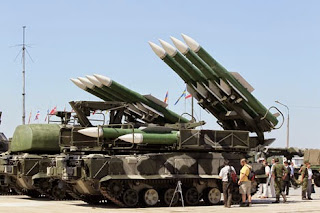Image : New Russian Buk-M3 Misile
Russia-wonderful success Range anti-aircraft missile system Buk-M3 is 70 km – about 25 km further than its predecessor, and with a number of new system parameters have exceeded long distance missile system S-300 defense system is reliably Russia during this time.
Trusted sources Russia Defense Ministry told TASS, Wednesday 20 may 2015 says, "test results showed that the system Thump-3 m there have been advances in technical and completely satisfies the requirements match the S-300, and with some parameters have exceeded even this system," said the Defense Ministry sources in Russia.
"Buk missile system
From Wikipedia, the free encyclopedia
For other uses, see Buk (disambiguation).
9K37 Buk
NATO reporting name:
SA-11 Gadfly, SA-17 Grizzly
Buk-M1-2 air defence system in 2010
Buk-M1-2 air defence system in 2010
Type Medium range SAM system
Place of origin Soviet Union
Service history
In service 1979–present
Used by See list of present and former operators
Wars See combat service
Production history
Designer
Almaz-Antey:
Tikhomirov NIIP (lead designer)
Lyulev Novator (SA missile designer)
MNIIRE Altair (naval version designer)
NIIIP (surveillance radar designer)
DNPP (missiles)
UMZ (TELARs)
MZiK (TELs)[1]
MMZ (GM chassis)
Variants 9K37 "Buk", 9K37M, 9K37M1 "Buk-M1", 9K37M1-2 "Buk-M1-2", 9K37M1-2A, 9K317 "Buk-M2", "Buk-M3"
naval: 3S90 (M-22), 3S90M, 3S90E1, 3S90M1
The Buk missile system (Russian: "Бук"; “beech” (tree), /bʊk/) is a family of self-propelled, medium-range surface-to-air missile systems developed by the Soviet Union and its successor state, the Russian Federation, and designed to fight cruise missiles, smart bombs, fixed- and rotary-wing aircraft, and unmanned aerial vehicles.
The Buk missile system is the successor to the NIIP/Vympel 2K12 Kub (NATO reporting name SA-6 "Gainful").[3] The first version of Buk adopted into service carried the GRAU designation 9K37 and was identified in the west with the NATO reporting name "Gadfly" as well as the US Department of Defense designation SA-11.
With the integration of a new missile the Buk-M1-2 and Buk-M2 systems also received a new NATO reporting name Grizzly and a new DoD designation SA-17. The latest incarnation "Buk-M3" is scheduled for production.
A naval version of the system, designed by MNIIRE Altair (currently part of GSKB Almaz-Antey) for the Russian Navy, according to Jane's Missiles & Rockets, received the GRAU designation 3S90M1 and will be identified with the NATO reporting name Gollum and a DoD designation SA-N-7C. The naval system is scheduled for delivery in 2014"
read the BUK-MISILE the Wikipedia
Image : New Russian Buk-M3 Misile
Image : New Russian Buk-M3 Misile
Image : New Russian Buk-M3 Misile
Image : New Russian Buk-M3 Misile
Image : New Russian Buk-M3 Misile
Image : New Russian Buk-M3 Misile
"First of all, the probability of Buk-3 m target reached 0,9999 against damage, which is not owned by the S-300," the source said. "This means that the system must be capable of destroying targets with one missile."
Moreover, according to that source, Buk-M3 has reached a maximum altitude of firing 22 miles. "the range of maximum destruction systems has increased by 25 km, as compared to its predecessor and reach 70 km. Range lower than the latter two characteristics have not changed, it meets the requirements," added the source.
A source in the Defense Ministry told TASS earlier that Buk-M3 system will be operational before the end of 2015, 2016 and begin shipping to the troops will be launched. The new complex is expected to continue the line of air defense system Thump. Previous modifications to the Buk-M2, currently considered one of the most efficient in its class. Development was completed in 1988, however, the production of the new series was released 15 years later.
Video New Russian Buk-M3 firing 9M317ME TPK MS-487 Missile







0 Response to "The SUCCESS of BUK-M3 to ACHIEVE the ABILITY of S-300"
Post a Comment